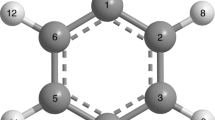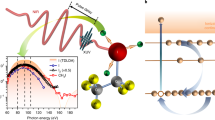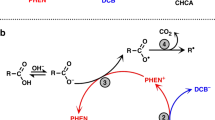Abstract
THE history of low energy photo-ionization in organic solutions began with the work of G. N. Lewis et al.1. Certain rigid organic solutions at 77° K were found to be photo-ionized by light quanta the energies of which were as little as half those required for gas phase ionization. More recently it has been demonstrated2 that very similar systems also undergo low energy photo-ionization in their fluid state at room temperature. To determine how the energy requirements are met, several workers3–5 have suggested that the mechanism of photo-ionization may involve two photons with a triplet state as a possible intermediate. The involvement of two photons in the photo-ionization of several benzene derivatives has now been clearly demonstrated in a rigid saturated hydrocarbon at 77° K by means of an analysis of the initial rise in the photoconductivity5. The results of these studies do not, however, suggest a triplet state as the intermediate state. For the molecule N, N, N′,N′-tetramethyl-p-phenylenediamine (TMPD) in 3-methyl-pentane (3-MP), an additional spectrophotometric study at 77° K revealed that the cation product, Wurster's blue, was also produced by a reaction involving two photons, and a triplet was identified as the intermediate state6. We have now completed a flash photoconductivity study of the same system in liquid solution at room temperature and find that the mechanism once again involves two photons. The nature of the intermediate state (or states) has not yet been established. In fact, energy considerations make it clear that inert solvents with low dielectric constant cannot radically alter the energy required for complete charge separation over that for the gaseous state. Thus low energy photo-ionizations which are well below (2–3 eV) the gaseous threshold must be expected to be no less than biphotonic whatever the details of the mechanism. The present extension of the earlier observations to a liquid would seem to confirm this point.
This is a preview of subscription content, access via your institution
Access options
Subscribe to this journal
Receive 51 print issues and online access
$199.00 per year
only $3.90 per issue
Buy this article
- Purchase on Springer Link
- Instant access to full article PDF
Prices may be subject to local taxes which are calculated during checkout
Similar content being viewed by others
References
Lewis, G. N., and Lipkin, D., J. Amer. Chem. Soc., 64, 2801 (1942); Lewis, G. N., and Bigeleisen, J., ibid., 65, 520 (1943).
Krog, U., Rüppel, H., and Witt, H. T., Ber. Bunsenges. Phys. Chem., 67, 795 (1963).
McClure, D. S., J. Chem. Phys., 19, 670 (1951).
Ermolaev, V. (personal communication).
Johnson, G. E., and Albrecht, A. C., J. Chem. Phys., 44, 3162 (1966), Part I; ibid., Part II.
Cadogan, K. D., and Albrecht, A. C., J. Chem. Phys., 43, 2550 (1965).
Pilloff, H. S. (to be published).
Pilloff, H. S., and Albrecht, A. C. (to be published).
Author information
Authors and Affiliations
Rights and permissions
About this article
Cite this article
PILLOFF, H., ALBRECHT, A. Direct Measurement of a Biphotonic Photo-ionization in Liquid Solution. Nature 212, 499–500 (1966). https://doi.org/10.1038/212499a0
Issue Date:
DOI: https://doi.org/10.1038/212499a0
This article is cited by
-
Ultraviolet irradiation-responsive dynamic ultralong organic phosphorescence in polymeric systems
Nature Communications (2021)
-
Organic long persistent luminescence
Nature (2017)
-
Influence of Oxygen on Photoconduction in Organic Solutions
Nature (1967)
Comments
By submitting a comment you agree to abide by our Terms and Community Guidelines. If you find something abusive or that does not comply with our terms or guidelines please flag it as inappropriate.



